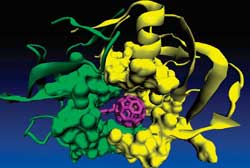Using computer simulations, the researchers tested over a hundred carbon fullerenes or as they are known in the field "Bucky-balls" to see if they could be used to inhibit the development of one of the strains of the AIDS virus by attaching them to its binding site.

Researcher Andrew Barron from Rice University and his group, in collaboration with other laboratories in Italy, Germany and Greece, were able to identify unique isolates that could block the ways in which the HIV virus - the deadly virus responsible for AIDS - spreads by preventing its ability to bind to other proteins.
Using computer simulations, the researchers examined over a hundred carbon fullerenes or as they are known in the field "buckyballs" (C60), which were first prepared for other purposes, to see if they could be used to inhibit the development of one of the strains of the AIDS virus (HIV -1 PR) by connecting them to his link site.
"There are many scientists who carry out this type of research, but usually it is one research group or one pharmaceutical company that takes a "shotgun" approach - prepare a pellet, test its activity, then prepare more and more pellets and try them as well while intelligently improving their properties," said the lead researcher, who is a professor of chemistry and materials science. "The approach is interesting because we are addressing the problem in a very intelligent way." The researchers published their findings in an article published in the scientific journal Journal of Chemical Information and Modeling.
Their method for simulating ways to fight the virus is not unique, but what was unique was the type of collaboration they had with research groups from five different institutions - two in Greece, one in Germany, one in Italy and the researcher's own group at the university - which was conducted through email contacts and discussions over many months, when each A group is working on another aspect of the issue. "There are groups that have not met each other in person," explains the lead researcher. The fascinating fact, he says, lies in the fact that the research has been carried out so far without any external funding.
The use of computer simulations to reduce the collection of tested fullerenes in order to find the most effective compound, is "the shortest and cheapest procedure for effective and intelligent drug design," the researchers wrote in the article.
"A relatively long time ago, various researchers noticed the fact that the C60 compound fits perfectly into the hydrophobic "pocket" of the virus, and has an inhibitory effect," explains the researcher. "This activity is not particularly strong, but it has the ability to be used to find histories whose activity is much stronger. The problem is that this is not the perfect outcome. The goal was to find an existing compound of fullerene origin that could be used as a source of modifications so that it would fit precisely."
The university entered this study, says the lead researcher, "since we prepared the compounds and our partners had an excellent method for computerized (in-silico) examination of them. They contacted us and asked if they could use some of the compounds. Immediately after that we started throwing together ideas for research.
"We started thinking about a very simple experiment to measure the effectiveness of a compound's affinity for the binding site of the virus, then perform these calculations for a collection of compounds and decide which one is the most effective - then prepare it in the laboratory and examine the nature of the correlation with the findings of the calculations," explains the researcher. "If the method works, then you have a way to design the perfect compound. Our research was the first step in this long process."
In the end, through their computer calculations, the researchers found two good matches among the history of fullerenes that were tested and now they are working on increasing their affinity efficiency in order to obtain that perfect compound, one that will bind to the virus as if it were Velcro and can be adjusted for additional strains.
"This is only one aspect of the problem - we do not expect to cure the disease, but only to delay and treat it," explains the researcher. The goal, he adds, is the development of a method for the rapid preparation of drugs that can act on different strains of the AIDS virus and other diseases.

One response
Dr. Moshe Nachmani:
Derivatives should be translated, in my opinion, to the word "derivatives" and not to the word "history".